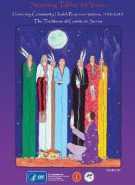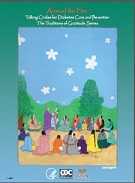Tradition of Gratitude Posters
The Traditions of Gratitude Series, was developed to honor traditional wisdom and evidence-based science portrayed through culturally relevant messages promoting health, diabetes prevention, and diabetes. Three images were created to honor Community Health Representatives (CHRs), Diabetes Talking Circles, and the Diabetes Prevention Program. The artist Sam English is renowned for his colorful and spiritually-inspired imagery. He is an Anishinabe, who are culturally-related indigenous peoples of Canada and the United States. Diagnosed with diabetes in 2001, English did not know until creating these images that there was hope for diabetes prevention and the prevention of complications due to diabetes. He is now a vital part of the voice that shares the hope for healing that Indian people and people everywhere long to hear. Read more about the posters and to down load the files
Standing Tall for 50 Years: Honoring Community Health Representatives, 1968-2018

The Standing Tall for 50 Years image celebrates the extraordinary contributions of Community Health Representatives (CHRs) serving tribal communities. The Indian Health Service CHR Program was established in 1968 to bridge cultural, language, and system gaps between people and health resources. Decades later, CHRs continue to “stand” for their people, providing social, spiritual and physical support, teaching about healthy traditional foods, the importance of being physically active, and helping people to live well with diabetes and to prevent type 2 diabetes in their communities.
Standing Tall for 50 Years – Consumer 8 x 10 PDF [PDF – 2 MB]
Standing Tall for 50 Years – Commercial Print File [PDF – 3 MB]
Standing Tall for 50 Years – Narrative [PDF – 128 KB]
Around the Fire: Talking Circles for Diabetes Care and Prevention

The Around the Fire image celebrates the tradition of talking circles, a traditional way of gathering groups of people to discuss important issues. Each person has a turn to speak while all others in the circle listen carefully. The image was inspired by Lorilei DeCora, a member of the Ho-Chunk Nation in Winnebago, Nebraska, and her tireless efforts to bring Diabetes Talking Circles to Indian Country. Four reservation communities in South Dakota and Nebraska participated in a study that demonstrated the value of talking circles in promoting hope for people with diabetes.
Around the Fire: Talking Circles – Consumer 8 x 10 PDF [PDF – 2M]
Around the Fire: Talking Circles – Commercial Print File [PDF – 8M]
Around the Fire: Talking Circles – Narrative [PDF – 122 KB]
They Changed the World! A Tribute to the Tribal Participants of the Diabetes Prevention Program and Other Diabetes Studies

The They Changed the World! image celebrates the courage and commitment of the American Indian participants of the Diabetes Prevention Program (DPP), sponsored by the National Institutes of Health (NIH) and Centers for Disease Control and Prevention (CDC). In 2001, the DPP, with 3,234 participants, including 171 American Indians, confirmed that type 2 diabetes can often be prevented or delayed by adopting a lifestyle of regular physical activity and healthy eating. This image honors the O’odham peoples of Arizona, Gila River and Salt River, who participated in the DPP. Other participants in the DPP included the Shiprock community of the Navajo Nation and Zuni Pueblo, both located in New Mexico.
They Changed the World! – Consumer 8 x 10 PDF [PDF – 2M]
They Changed the World! – Commercial Print File [PDF – 9M]
They Changed the World! – Narrative [PDF – 91 KB]
- Page last reviewed: November 15, 2016
- Page last updated: November 15, 2016
- Content source:
- Maintained By:
- National Center for Chronic Disease Prevention and Health Promotion, Division of Diabetes Translation


 ShareCompartir
ShareCompartir